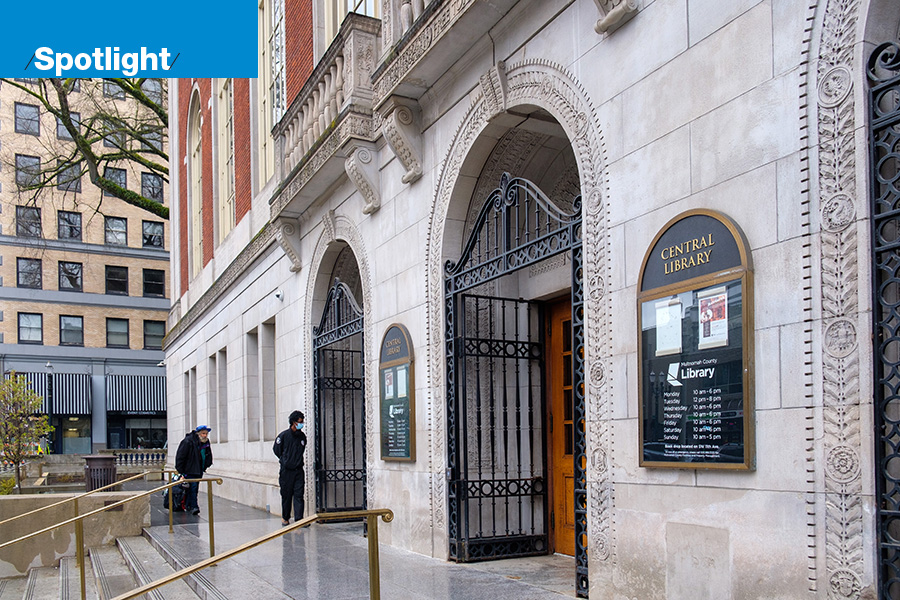Multnomah County’s Central Library was built in 1893 and last renovated around the time of its 100th birthday. Now it’s undergone another refresh — one meant to bring it in line with library trends.
From the outside, Multnomah County’s Central Library doesn’t look much different than it did when it closed early last year. There’s more outdoor seating — and hopes for outdoor events, including concerts, this summer — but it’s still the same three-story brick building that has occupied a city block at Southwest 10th and Yamhill for 131 years.
Inside the building, the change is a little more obvious — especially on the first floor.
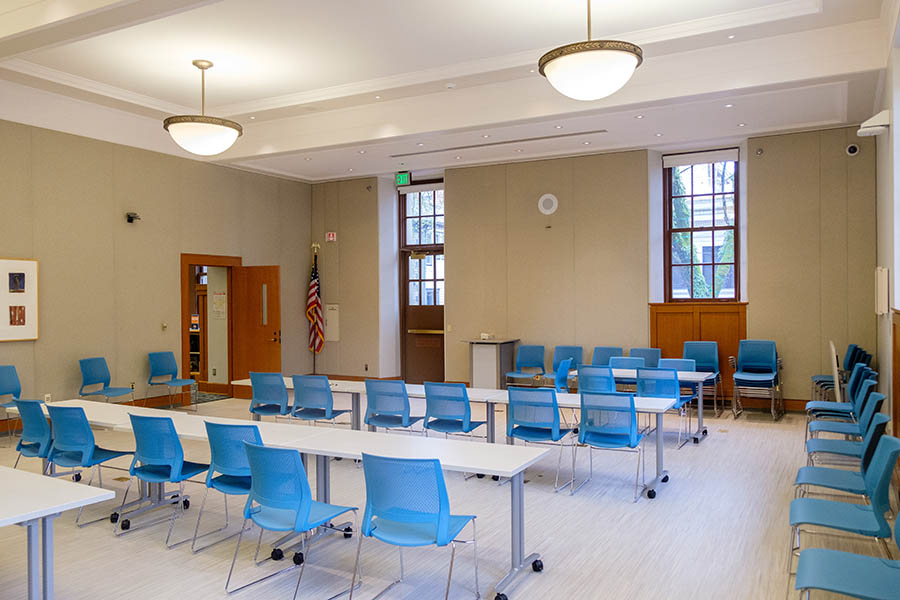
The Friends of the Library bookstore has been moved from its out-of-the-way corner right off the foyer to a glass-walled space at the center of the first floor. Patrons can still pick up books on hold from the first floor, but what used to be the beginning of what was called the Popular Library — mostly adult fiction, teen material and new books, all in English — is now a collection of works in four languages, as well as large print. The fiction collection is now on the second floor, in a room previously occupied by periodicals — which are still on the second floor but have moved to the north side of the building.
Other areas look more familiar. The Beverly Cleary Children’s Room has retained much of its familiar and much-loved art, including a bas-relief of Alice in Wonderland (made during the 1930s as part of the Works Progress Administration’s federal arts project) and an elaborate bronze tree sculpture made by Dana Lynn Louis and Barbara Eiswerth for the 1993 remodel.
But books for teenagers have their own section within the children’s room, and there’s now a meeting room inside the children’s room for kids’ events, including teen book clubs.
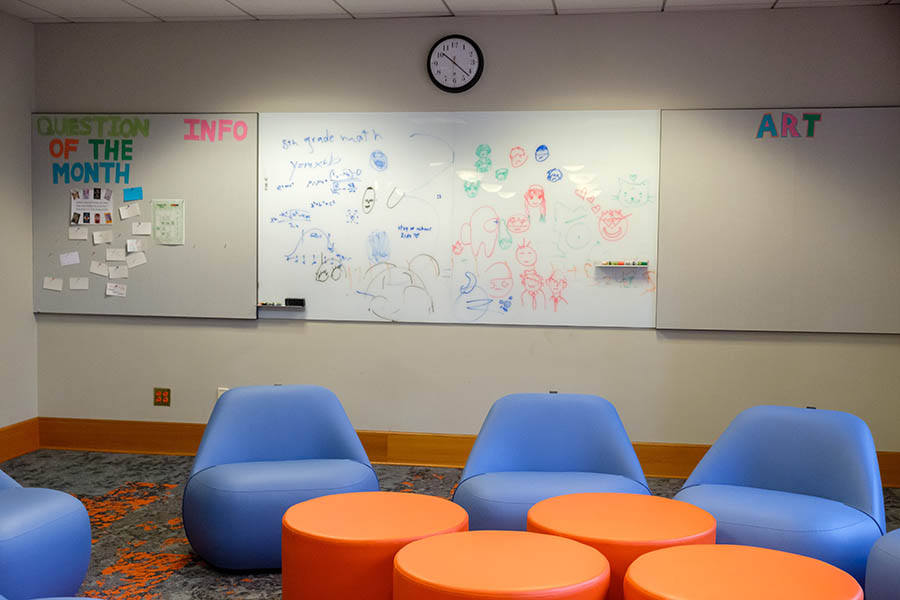
“Anyone who has teens knows they want their own spot,” Shelly Jarman, the Central Library’s regional manager, told Oregon Business during a March tour of the building, which reopened in February.
The Central Library’s recent remodel is the result of a bond measure passed by voters in 2020 that provides $387 million — $13 million of which went to the Central Library — to update buildings throughout the library system. Some of the decisions are simple technological shifts, like installing an automatic sorting system, which Jarman says every other large library system in the country already has. Others reflect the changing needs of patrons, who are increasingly likely to read e-books rather than physical books, and increasingly likely to request physical books online rather than browsing. And other changes simply reflect the changing meaning of libraries — as shared public spaces with no commercial purpose and, increasingly, frontline social services providers.
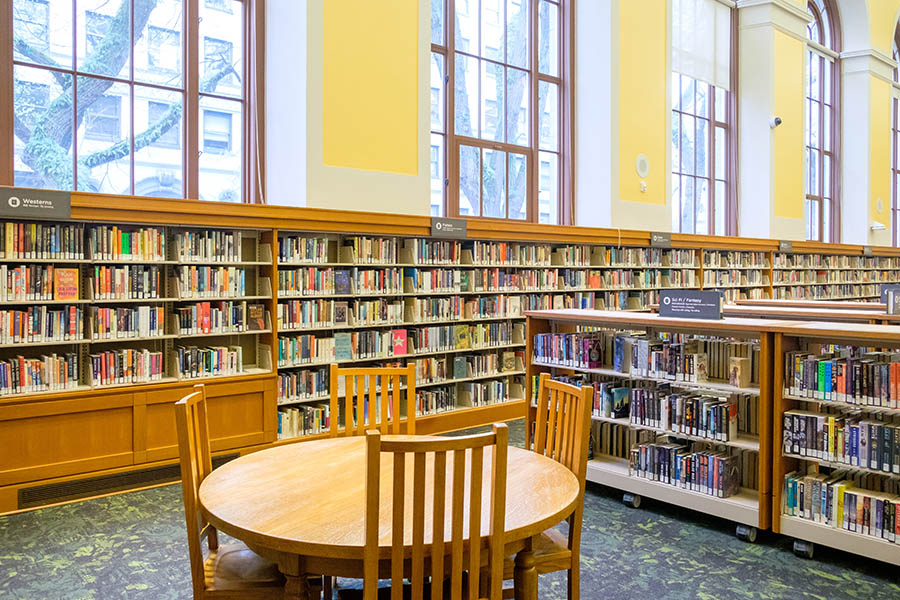
Among the most noticeable changes at the Central Library: The bookshelves are shorter, and there aren’t as many of them.
That’s true in the children’s room but also throughout the building, where most — but not all — of the towering shelves have been replaced with 45- or 54-inch shelves.
There are several reasons shelves are shorter. In the children’s room, there was a fairly intuitive reason to bring shelf heights down: Tall, cavernous shelves — most were more than seven feet tall — just aren’t accessible for shorter patrons, including new readers.
The old shelves were also not accessible to wheelchair users of any height, and the new, shorter shelves are more earthquake-safe.
And then there is the matter of security.
“When the shelves are lower, you can see across the entire space,” Jarman says, making it easier for staff to monitor behavior in the facility.
But the reduced number of shelves may be the most noticeable change — and the one most remarked upon, even before the remodel had finished.
In February 2023, Willamette Week reported that the number of books and periodicals available at the Central Library would be reduced by 49.7% after the refresh — from 394,723 to 198,534.
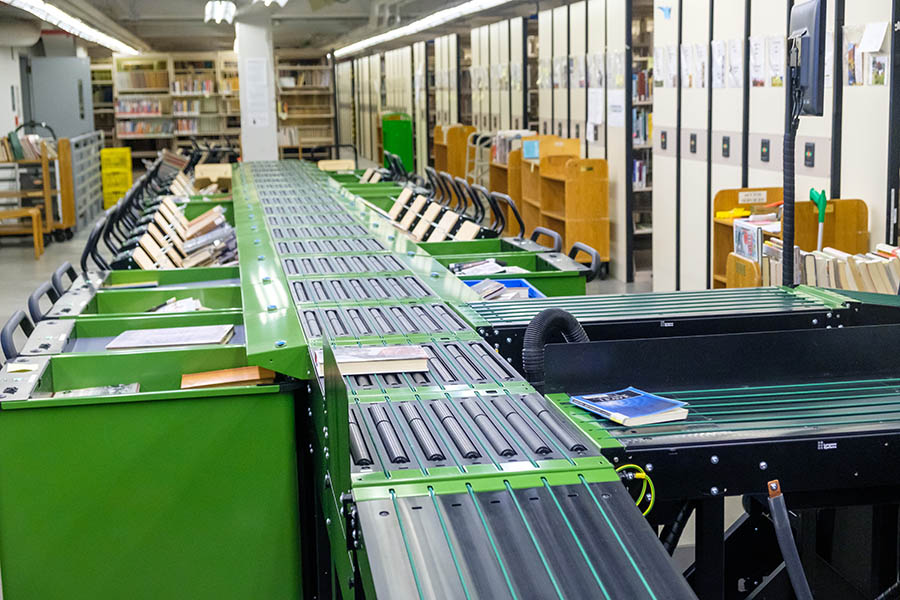
“All of us that love libraries, we like to get lost in the books,” Jarman says. Some areas in the Central Library still include high shelves, and the library’s overall circulation has not changed, according to library spokesperson Shawn Cunningham. And in fact, the number of materials in circulation at Central didn’t reduce by as much as anticipated: There are now about 267,000 items on browsable shelves, and about 220,000 are in closed stacks — reserved for items that rarely circulate — at Central.
The bond has helped fund the construction of an operations center at Northeast 122nd and Glisan, where physical materials like books and other items can be stored. Cunningham says about 140,000 books were moved from Central to the operations center during the refresh; the site currently holds 273,000 items, and will be able to hold 500,000 items at full capacity.
About 40% of checkouts happen through a hold, according to Cunningham, and having a central storage space streamlines the logistical process through which holds are fulfilled.

The relative ease — at least for tech-savvy patrons — of requesting a book through the library’s website isn’t the only way in which Multnomah County is adapting to technological changes. The common areas in Central Library are now dotted with large portable charging stations at which patrons can charge their devices, a change that required some minor electrical work, Jarman says.
Another major change — one that was already in progress but that accelerated after the COVID-19 pandemic hit — is the rise of e-books. According to Cunningham, the number of digital checkouts in fiscal year 2023 was 5.8 million, up from 3.5 million in 2019.
“It’s not that people aren’t still reading print books — a lot of people still do — but that balance has shifted quite a bit in terms of people’s preferences,” says library director Vailey Oehlke.
That’s not a bad thing in any librarian’s eyes — having more ways to access books is always a net positive — but the ascendance of e-books has also posed some notable challenges for library budgets.
When a person or institution buys a physical book, “it’s my copy of the book,” Wendy Cornelisen, state librarian for the state of Oregon, tells Oregon Business. “Copyright gives me the power as the owner now of this book to do whatever I want with it. When I’m done with it, I can resell it, I can give it to the library, I can pass it off to friends to read and hope they bring it back. But this is my property. This is my book.”
With e-books the terms are different.
“For the most part, when libraries are contracting with — usually not directly with a publisher — but with a third-party aggregator, they are licensing content, so there are license terms for that e-book. It’s essentially renting the title for a specific period of time. One of the things that we’ve seen recently in that e-book marketplace is that publishers are putting forth terms through the aggregators that limit the number of times an e-book can be checked out. There are some terms that are like, ‘Hey, library, you can have that book checked out 26 times,’ which kind of feels a little arbitrary.”
Digital licenses cost more than the purchase of a physical book — and they also cost more than it would cost a consumer to purchase an e-book. In 2019 the American Library Association used the example of the 2014 novel All the Light We Cannot See. At that time, an individual consumer would pay $12.99 for a digital version of the book; a library would pay about $52 to license it for two years.
“They say things like, ‘Oh, well, our research has shown that the average print material only circulates 13 times before it falls apart.’ Well, OK, where’d you get that information from? How do you know? Like, did you talk to us?” says Buzzy Nielsen, the program manager for State Library Services for the State Library of Oregon.
When e-books were new, a purchase was much more like a traditional book purchase, and libraries could keep electronic copies forever. But the shifting terms have driven library costs way up. Nielsen served as library director of the Crook County Library from 2016 to 2020, and he estimates that in his time there, the amount of money the library spent on digital acquisitions more than doubled, from about $15,000 a year to about $35,000 a year. In Multnomah County, the digital acquisitions budget for 2023 — $1.5 million — is up only slightly from 2019, when it was $1.2 million.
Legislatures in some states have sought more reasonable terms for e-book access, and there have been conversations at the federal level as well. Oehlke and Cornelisen say they’re hoping to see some change, either at the federal or state level.

“I’ve been hoping that we can get some traction here in Oregon, and so far that hasn’t happened, but I’m not giving up,” Oehlke says.
One of the other changes that’s immediately noticeable when one enters the new Central Library: There’s an office just off the entryway, near the location of the former bookstore, for community resource counselors. Since 2016 Cascadia Health has staffed a Library Crisis Team to provide resources to patrons, but having a visible but private office for the resource workers is new.
In 2021, according to Cascadia, the crisis team served 454 clients: 43% were houseless, 11% were housed and 46% had an unknown housing status.
The nature of the services provided varies, Cunningham says. Sometimes it’s a matter of connecting patrons with food, shelter or jobs, and sometimes it’s a matter of working with a patron in acute crisis to calm them down.
Part of the idea is to take a more proactive approach to security — with the understanding that libraries are one of few spaces where members of the public are welcome, without the expectation that they buy something in order to be allowed to sit down or use the bathroom.
Since OB’s visit to the Central Library, branches across the system have experienced service disruptions due to a change in the union contract that means library staff can’t be required to serve as the person in charge of security concerns if they are the only person on duty. A March audit found that more than 40% of Multnomah County library staff feel unsafe at work, reporting more than 2,000 violations of library rules between January and December 2022, more than half of which took place at the Central Library. Incidents reported include violent threats, sexual harassment and drug overdoses — and staff noted that police rarely responded when 911 was called. They did note that they feel safer at work when there is a security person on the job, which most library branches have.
“What we’re seeing outside, on the streets and in the parks of our community — that behavior is also happening in library buildings,” Oehlke says. In addition to hiring social workers and security guards, the library is looking into hiring peer support specialists to work directly with people dealing with addiction.
Multnomah County Library is not alone in offering social services to patrons — either in the state or nationwide — or in making more space for community gatherings, whether in small, informal reading areas or meeting rooms, which according to Jarman and Oehlke are in consistent high demand.
“That is a very strong story coming out of urban libraries now, where I think you have seen an increase in numbers, or you have seen an increase in the depth of service and the depth of need that people have coming in — particularly post-pandemic,” says Stephanie Chase, the executive director for Libraries of Eastern Oregon, who is also serving on the executive board of directors for the American Library Association. “Rural libraries have really had that on their plates for a long time. When you’re working in a small community, you have a real sense of who’s struggling. There are not a lot of places to go to try to find help.”
While smaller libraries may not have social workers on staff, many are shifting their approach — and training — to address increasing rates of homelessness in rural areas, as well as ongoing problems with |substance abuse around the state. And Chase is aware of some pilot programs to increase access to social services through libraries in Eastern Oregon.
“There’s this transition to really needing to do more mental health support, access of benefits, any of these types of things, and in an urban setting, you’ll see a volume. It’s really about quantity. I think that’s what’s challenging for our urban-library colleagues. Now it’s like a day doesn’t go by where you’re really having to work, or interact with somebody who’s really, really in crisis and may not be capable of being in that public space,” Chase says.
“These buildings, they don’t belong to the library, to us as staff — they belong to the community, and everyone has a constitutional right to access the public library,” Oehlke says. “Our job is to maintain those spaces, make sure they’re functional and serve the needs of our community, and also to make that access as sort of low-barrier as possible, so that everyone has access to that space.”
The Central Library is Multnomah County’s largest physical library — it’s 122,000 square feet. But it’s not the only building getting some work done with bond funding. Other branches are getting either major or minor renovations — and in a few cases, new buildings.
The 2020 bond will also fund construction of a completely new Holgate Library building — due to open in the summer of 2024 — and a new, larger Northwest Library branch. The bond will also fund a new branch comparable in size to Central, the East County Library, sited in Gresham and due to open in 2026. The Albina, Belmont, Midland, North Portland and St. Johns libraries will also be renovated with bond funds — and all renovations will add square footage to the spaces.
The past year’s work on the Central Library has been described as a refresh — sort of a minor renovation — and 10 others will undergo a similar level of improvement.
The Central Library reopened in February with a Lunar New Year Celebration on the third floor, which doubles as a gallery space. And there is talk of more events, including possible outdoor concerts over the summer.
For her part, Oehlke, 58, is retiring, though she expects to continue to advocate for libraries post-retirement.
“Public libraries are amazing, you know — this concept that we all pitch in our money create this resource that’s open for free to anyone, no matter who they are, no matter their background, no matter their resources,” Oehlke says. “I talk a lot about libraries as platforms for self-determination, that you get to decide how you use the library, how it is meaningful to you. It helps you. Whatever journey you’re on, it will help you — with resources or knowledge or connection to help you on that path. And there’s no flipping way we would invent public libraries in this day and age. I think it’s amazing that we have them.”
Click here to subscribe to Oregon Business.

